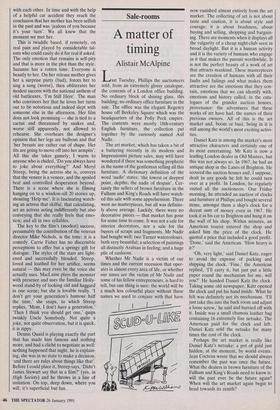Sale-rooms
A matter of timing
Alistair McAlpine
Last Tuesday, Phillips the auctioneers sold, from an extremely glossy catalogue, the contents of a London office building. No ordinary block of shining glass, this building; no ordinary office furniture in the sale. The office was the elegant Regency house off Berkeley Square which was the headquarters of the Polly Peck empire. The contents were mostly 18th-century English furniture, the collection put together by the curiously named Asil Nadir.
The art market, which has taken a bit of a battering recently in its modern and Impressionist picture sales, may well have wondered if there was something prophetic in the name of the gentleman selling all this furniture. A dictionary definition of the word 'nadir' states: 'the lowest or deepest point, depths; the nadir of despair'. Cer- tainly the sellers of brown furniture in the Fulham and King's Roads will have watch- ed this sale with some apprehension. There were no masterpieces, but all was definite- ly above average. Luckily, there were no decorative pieces — that market has gone for some time to come. It was not a sale for interior decorators, nor a sale for the buyers of scraps and fragments. Mr Nadir had bought well: two Turner watercolours, both very beautiful; a selection of paintings all distinctly Arabian in feeling; and a huge pile of cushions.
Whether Mr Nadir is a victim of our times and the current recession that oper- ates in almost every area of life, or whether our times are the victim of Mr Nadir and some of his fellow entrepreneurs, is hard to tell, but one thing is sure: the world will be a much less colourful place without these names we used to conjure with that have. now vanished almost entirely from the art market. The collecting of art is not about taste and caution, it is about style and courage; it is about brashness, about buying and selling, shopping and bargain- ing. There are moments when it displays all the vulgarity of a cheap night-club seen in broad daylight. But it is a human activity and it is the variety of humans who engage in it that makes the pursuit worthwhile. It is not the perfect beauty of a work of art that attracts mankind. These masterpieces are the creation of humans with all their faults and failings and what makes them attractive are the emotions that they con- tain, emotions that we can identify with, emotions and history called, in the cata- logues of the grander auction houses, provenance: the adventures that these works of art have had, the names of their previous owners. All of this is the art market and, boom or. bust, being in it is still among the world's most exciting activi- ties.
Daniel Katz is among the market's most attractive characters and certainly one of its most entertaining. Mr Katz is now a leading London dealer in Old Masters, but this was not always so. In 1967, he had an antique shop in the Lanes of Brighton. He scoured the auction houses and, I suppose, dealt in any goods he felt he could turn over at a profit. In London, he regularly visited all the auctioneers. One Friday morning, he attended an auction of clocks and furniture at Phillips and bought several items, amongst them a ship's clock for a decent sum of money even in 1967. He took it in his car to Brighton and hung it on the wall of his shop. Within minutes, an American tourist entered the shop and asked him the price of the clock. He quoted a price that included a good profit. `Done,' said the American. 'How heavy is it?'
`Oh, very light,' said Daniel Katz, eager to avoid the expense of packing and shipping the clock. 'Fine,' the American replied, 'I'll carry it, but just put a little paper round the mechanism for me, will you?' He handed Daniel Katz the clock.
Taking some old newspaper, Katz opened the clock and put his hand inside. What he felt was definitely not its mechanism. 'I'll just take this into the back room and adjust a loose screw,' he said and hurried off with it. Inside was a small chamois leather bag containing 16 extremely fine netsuke. The American paid for the clock and left. Daniel Katz sold the netsuke for many times the cost of the clock.
Perhaps the art market is really like Daniel Katz's netsuke: a pot of gold just hidden, at the moment, by world events.
Jean Cocteau wrote that we should always remember the past was once the future.
What the dealers in brown furniture of the Fulham and King's Roads need to know is: will the past ever be the future again? When will the art market again begin to head towards its zenith?


























































 Previous page
Previous page